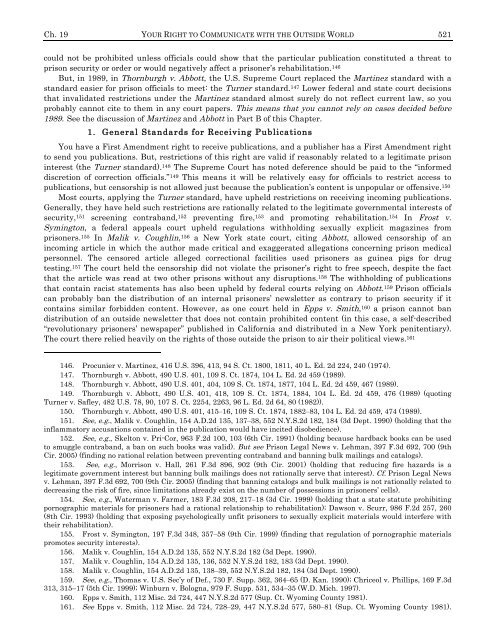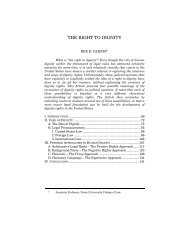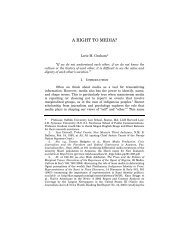Your Right to Communicate With the Outside World - Columbia Law ...
Your Right to Communicate With the Outside World - Columbia Law ...
Your Right to Communicate With the Outside World - Columbia Law ...
- No tags were found...
Create successful ePaper yourself
Turn your PDF publications into a flip-book with our unique Google optimized e-Paper software.
Ch. 19 YOUR RIGHT TO COMMUNICATE WITH THE OUTSIDE WORLD 521could not be prohibited unless officials could show that <strong>the</strong> particular publication constituted a threat <strong>to</strong>prison security or order or would negatively affect a prisoner’s rehabilitation. 146But, in 1989, in Thornburgh v. Abbott, <strong>the</strong> U.S. Supreme Court replaced <strong>the</strong> Martinez standard with astandard easier for prison officials <strong>to</strong> meet: <strong>the</strong> Turner standard. 147 Lower federal and state court decisionsthat invalidated restrictions under <strong>the</strong> Martinez standard almost surely do not reflect current law, so youprobably cannot cite <strong>to</strong> <strong>the</strong>m in any court papers. This means that you cannot rely on cases decided before1989. See <strong>the</strong> discussion of Martinez and Abbott in Part B of this Chapter.1. General Standards for Receiving PublicationsYou have a First Amendment right <strong>to</strong> receive publications, and a publisher has a First Amendment right<strong>to</strong> send you publications. But, restrictions of this right are valid if reasonably related <strong>to</strong> a legitimate prisoninterest (<strong>the</strong> Turner standard). 148 The Supreme Court has noted deference should be paid <strong>to</strong> <strong>the</strong> “informeddiscretion of correction officials.” 149 This means it will be relatively easy for officials <strong>to</strong> restrict access <strong>to</strong>publications, but censorship is not allowed just because <strong>the</strong> publication’s content is unpopular or offensive. 150Most courts, applying <strong>the</strong> Turner standard, have upheld restrictions on receiving incoming publications.Generally, <strong>the</strong>y have held such restrictions are rationally related <strong>to</strong> <strong>the</strong> legitimate governmental interests ofsecurity, 151 screening contraband, 152 preventing fire, 153 and promoting rehabilitation. 154 In Frost v.Syming<strong>to</strong>n, a federal appeals court upheld regulations withholding sexually explicit magazines fromprisoners. 155 In Malik v. Coughlin, 156 a New York state court, citing Abbott, allowed censorship of anincoming article in which <strong>the</strong> author made critical and exaggerated allegations concerning prison medicalpersonnel. The censored article alleged correctional facilities used prisoners as guinea pigs for drugtesting. 157 The court held <strong>the</strong> censorship did not violate <strong>the</strong> prisoner’s right <strong>to</strong> free speech, despite <strong>the</strong> factthat <strong>the</strong> article was read at two o<strong>the</strong>r prisons without any disruptions. 158 The withholding of publicationsthat contain racist statements has also been upheld by federal courts relying on Abbott. 159 Prison officialscan probably ban <strong>the</strong> distribution of an internal prisoners’ newsletter as contrary <strong>to</strong> prison security if itcontains similar forbidden content. However, as one court held in Epps v. Smith, 160 a prison cannot bandistribution of an outside newsletter that does not contain prohibited content (in this case, a self-described“revolutionary prisoners’ newspaper” published in California and distributed in a New York penitentiary).The court <strong>the</strong>re relied heavily on <strong>the</strong> rights of those outside <strong>the</strong> prison <strong>to</strong> air <strong>the</strong>ir political views. 161146. Procunier v. Martinez, 416 U.S. 396, 413, 94 S. Ct. 1800, 1811, 40 L. Ed. 2d 224, 240 (1974).147. Thornburgh v. Abbott, 490 U.S. 401, 109 S. Ct. 1874, 104 L. Ed. 2d 459 (1989).148. Thornburgh v. Abbott, 490 U.S. 401, 404, 109 S. Ct. 1874, 1877, 104 L. Ed. 2d 459, 467 (1989).149. Thornburgh v. Abbott, 490 U.S. 401, 418, 109 S. Ct. 1874, 1884, 104 L. Ed. 2d 459, 476 (1989) (quotingTurner v. Safley, 482 U.S. 78, 90, 107 S. Ct. 2254, 2263, 96 L. Ed. 2d 64, 80 (1982)).150. Thornburgh v. Abbott, 490 U.S. 401, 415–16, 109 S. Ct. 1874, 1882–83, 104 L. Ed. 2d 459, 474 (1989).151. See, e.g., Malik v. Coughlin, 154 A.D.2d 135, 137–38, 552 N.Y.S.2d 182, 184 (3d Dept. 1990) (holding that <strong>the</strong>inflamma<strong>to</strong>ry accusations contained in <strong>the</strong> publication would have incited disobedience).152. See, e.g., Skel<strong>to</strong>n v. Pri-Cor, 963 F.2d 100, 103 (6th Cir. 1991) (holding because hardback books can be used<strong>to</strong> smuggle contraband, a ban on such books was valid). But see Prison Legal News v. Lehman, 397 F.3d 692, 700 (9thCir. 2005) (finding no rational relation between preventing contraband and banning bulk mailings and catalogs).153. See, e.g., Morrison v. Hall, 261 F.3d 896, 902 (9th Cir. 2001) (holding that reducing fire hazards is alegitimate government interest but banning bulk mailings does not rationally serve that interest). Cf. Prison Legal Newsv. Lehman, 397 F.3d 692, 700 (9th Cir. 2005) (finding that banning catalogs and bulk mailings is not rationally related <strong>to</strong>decreasing <strong>the</strong> risk of fire, since limitations already exist on <strong>the</strong> number of possessions in prisoners’ cells).154. See, e.g., Waterman v. Farmer, 183 F.3d 208, 217–18 (3d Cir. 1999) (holding that a state statute prohibitingpornographic materials for prisoners had a rational relationship <strong>to</strong> rehabilitation); Dawson v. Scurr, 986 F.2d 257, 260(8th Cir. 1993) (holding that exposing psychologically unfit prisoners <strong>to</strong> sexually explicit materials would interfere with<strong>the</strong>ir rehabilitation).155. Frost v. Syming<strong>to</strong>n, 197 F.3d 348, 357–58 (9th Cir. 1999) (finding that regulation of pornographic materialspromotes security interests).156. Malik v. Coughlin, 154 A.D.2d 135, 552 N.Y.S.2d 182 (3d Dept. 1990).157. Malik v. Coughlin, 154 A.D.2d 135, 136, 552 N.Y.S.2d 182, 183 (3d Dept. 1990).158. Malik v. Coughlin, 154 A.D.2d 135, 138–39, 552 N.Y.S.2d 182, 184 (3d Dept. 1990).159. See, e.g., Thomas v. U.S. Sec’y of Def., 730 F. Supp. 362, 364–65 (D. Kan. 1990); Chriceol v. Phillips, 169 F.3d313, 315–17 (5th Cir. 1999); Winburn v. Bologna, 979 F. Supp. 531, 534–35 (W.D. Mich. 1997).160. Epps v. Smith, 112 Misc. 2d 724, 447 N.Y.S.2d 577 (Sup. Ct. Wyoming County 1981).161. See Epps v. Smith, 112 Misc. 2d 724, 728–29, 447 N.Y.S.2d 577, 580–81 (Sup. Ct. Wyoming County 1981).















